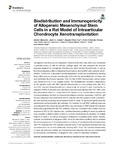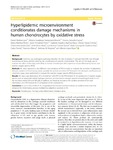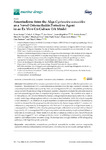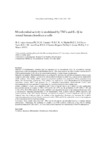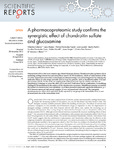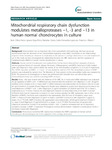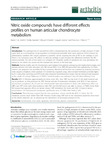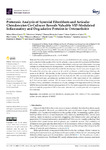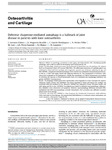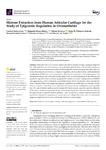Buscar
Mostrando ítems 1-10 de 17
Biodistribution and Immunogenicity of Allogeneic Mesenchymal Stem Cells in a Rat Model of Intraarticular Chondrocyte Xenotransplantation
(Frontiers, 2017-11-06)
[Abstract] Xenogeneic chondrocytes and allogeneic mesenchymal stem cells (MSC) are considered a potential source of cells for articular cartilage repair. We here assessed the immune response triggered by xenogeneic ...
Hyperlipidemic microenvironment conditionates damage mechanisms in human chondrocytes by oxidative stress
(BMC, 2017-06-12)
[Abstract] Background, Currently, two pathogenic pathways describe the role of obesity in osteoarthritis (OA); one through biomechanical stress, and the other by the contribution of systemic inflammation. The aim of this ...
Amentadione from the Alga Cystoseira usneoides as a Novel Osteoarthritis Protective Agent in an Ex Vivo Co-Culture OA Model
(MDPI, 2020-12-07)
[Abstract] Osteoarthritis (OA) remains a prevalent chronic disease without effective prevention and treatment. Amentadione (YP), a meroditerpenoid purified from the alga Cystoseira usneoides, has demonstrated anti-inflammatory ...
Mitochondrial activity is modulated by TNFα and IL-1β in normal human chondrocyte cells
(Elsevier, 2006-05-05)
[Abstract] Objective. Pro-inflammatory cytokines play an important role in osteoarthritis (OA). In osteoarthritic cartilage, chondrocytes exhibit an alteration in mitochondrial activity. This study analyzes the effect of ...
A pharmacoproteomic study confirms the synergistic effect of chondroitin sulfate and glucosamine
(Nature, 2014-06-10)
[Abstract] Osteoarthritis (OA) is the most common age-related rheumatic disease. Chondrocytes play a primary role in mediating cartilage destruction and extracellular matrix (ECM) breakdown, which are main features of the ...
Mitochondrial Respiratory Chain Dysfunction Modulates Metalloproteases -1, -3 and -13 in Human Normal Chondrocytes in Culture
(BioMed Central, 2013-08-09)
[Abstract] Background. Mitochondrion has an important role in the osteoarthritis (OA) pathology. We have previously demonstrated that the alteration of the mitochondrial respiratory chain (MRC) contributes to the inflammatory ...
Nitric Oxide Compounds Have Different Effects Profiles on Human Articular Chondrocyte Metabolism
(BioMed Central, 2013-09-11)
[Abstract] Introduction. The pathogenesis of osteoarthritis (OA) is characterized by the production of high amounts of nitric oxide (NO), as a consequence of up-regulation of chondrocyte-inducible nitric oxide synthase ...
Proteomic Analysis of Synovial Fibroblasts and Articular Chondrocytes Co-Cultures Reveals Valuable VIP-Modulated Inflammatory and Degradative Proteins in Osteoarthritis
(MDPI, 2021-06-16)
[Abstract] Osteoarthritis (OA) is the most common musculoskeletal disorder causing a great disability and a reduction in the quality of life. In OA, articular chondrocytes (AC) and synovial fibroblasts (SF) release ...
Defective chaperone-mediated autophagy is a hallmark of joint disease in patients with knee osteoarthritis
(Elsevier, 2023-03-08)
[Abstract] Objective: Defects in autophagy contribute to joint aging and Osteoarthritis (OA). Identifying specific autophagy types could be useful for developing novel treatments for OA.
Design: An autophagy-related ...
Histone Extraction From Human Articular Cartilage for the Study of Epigenetic Regulation in Osteoarthritis
(MDPI, 2022-03-20)
[Abstract] Osteoarthritis (OA) is a chronic disease that affects articular cartilage, causing its degeneration. Although OA is one of the most prevalent pathologies globally, there are no definitive treatments available. ...


